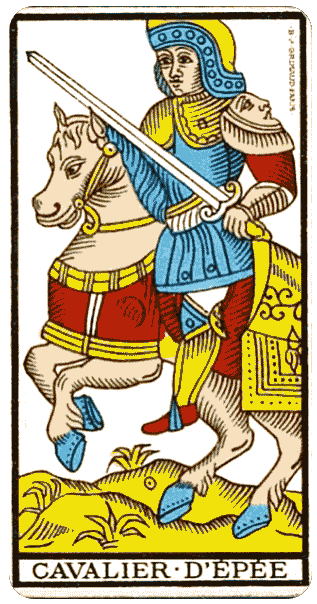synthetic meaning
This card depicts a Knight dressed in armor, holding a while sword and mounted on a galloping horse, flesh-colored, partially covered by fabric and whose shoes are blue. It symbolizes therefore the force of sudden propagation, powerful, enlightened, and disciplined, depending on the vital energies of the physical world and propagating themselves through animistic qualities.
analytic meaning
The blue armor of the Knight of Swords shows an energetic will, one disciplined by an animistic nature. The mask which he wears on his left shoulder marks the fact that the power granted the Knight is transitory and does not belong to him, since it disappears along with the armor from which, moreover, he can be detached.
The long sword, not colored, as well as the hilt, indicate by their whiteness a synthetic force from the light and, consequently a force directed towards the higher planes; it still specifies an abstract note, that is to say, that it does not reveal the plane on which its action will be directed.
The fabrics which cover the horse, while covering it with flexible substances, but still material, show that the fulcrum and the transmission of the force of the Knight (the flesh color of the horse) is surrounded and protected by the vital energies of the physical world.
These fabrics, forming a caparison, are for the most part red, with a yellow border above and below, connected in front by a white band, thus signifying that his actions will be intelligent and balanced. The various patterns, arabesque and black points appearing on the yellow part represent the material parts which have not yet evolved.
The shoe, the point of contact with the ground, is blue.[1] This indicates the spiritual basis of his progress. The iron of the horseshoe is fastened with five nails,[2] five being the number of the vibration, which is to say, of the propagation of a state or a plan to another state or plan. The number 10, figured by the ten nails which border the visible part of his helmet (or 2 x 5) accentuate this idea, but moreover it recalls the 10th Arcanum, the Wheel of Fortune, because the Knight of Swords introduces, depending on the environment, the promotion of evolution, or a renewal of something in the events, a change of situation; in a word, the unexpected.
The blue of his breastplate and helmet show that the spiritual is protecting him him in his struggle, and the yellow shows that this protection is a matter of intelligence. His white belt, on the blue background of his breastplate, indicates that his spirituality is based on purity. The Knight must stand firmly in his spirituality by the blue stirrups which are fitted to his red feet, and the yellow of his leg touching the top of the stirrup signifies that intelligence must proceed to the spiritual. His knee pad, blue in front and yellow on the back, confirms the preceding.
The mane serves to swat away insects; it is here depicted in blue, showing therefore that it is the spiritual flyswatter which will shoo away the parasites disposed to attach themselves to his will.
The galloping of the horse indicates the sudden apparition of force propagatedby the Knight of Swords. The oblique direction of the horse, while marking the passive orientation of the Knight, shows that while it is not the origin of what the Knight is pursuing, it is permitting a rapid advance towards an engaging activity. Its four blue shoes underscore its spiritual direction.
The flesh-colored mask which the knight wears on his shoulder also symbolizes the physical heredity which his struggles waged at sword point must destroy and dissipate their defects as well as the burden which this heredity imposes on him. It is on the physical plane that he must strike them, for his upper part of his sword arm is red, and his forearm and hand are flesh-colored.
The yellow ground, rugged and streaked with black lines, represents points of resistance; some yellow tufts of grass represent intellectual contributions coming to his aid.
meanings as they relate to the three planes
MENTAL. Source of clarity brought to bear on projects and their solution, unexpectedly, by showing their multiple aspects.
ANIMIQUE. Exchange, something quickly supplied and vibrant, since the horse is galloping.
PHYSICAL. Unexpected achievement which nothing predicted.
INVERTED. Great embarrassment, disputes, decline in business.
In sum, in its Elementary Sense, the Knight of Swords represents Man's quick command; a reflexive decision before an unanticipated event, one not foreseen by fate.
[1] The horseshoes of the four Knights' horses are all blue, marking thus the spiritual basis of their action.
[2] This detail may also be found in the other three Knights.
@nifo@innergarden.org
Inner Garden Foundation
P.O. Box 8520, 3542AD
Utrecht, The Netherlands
